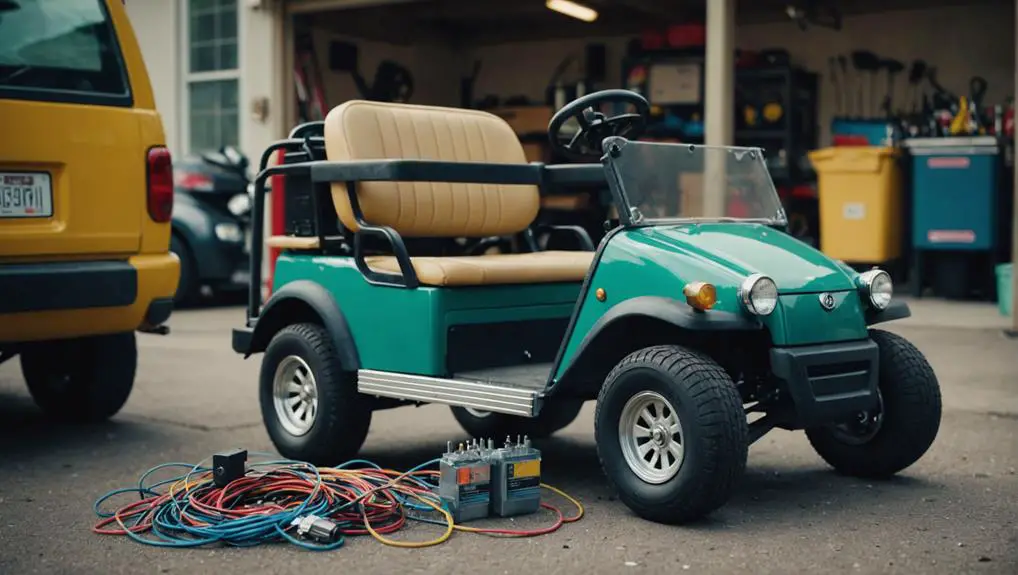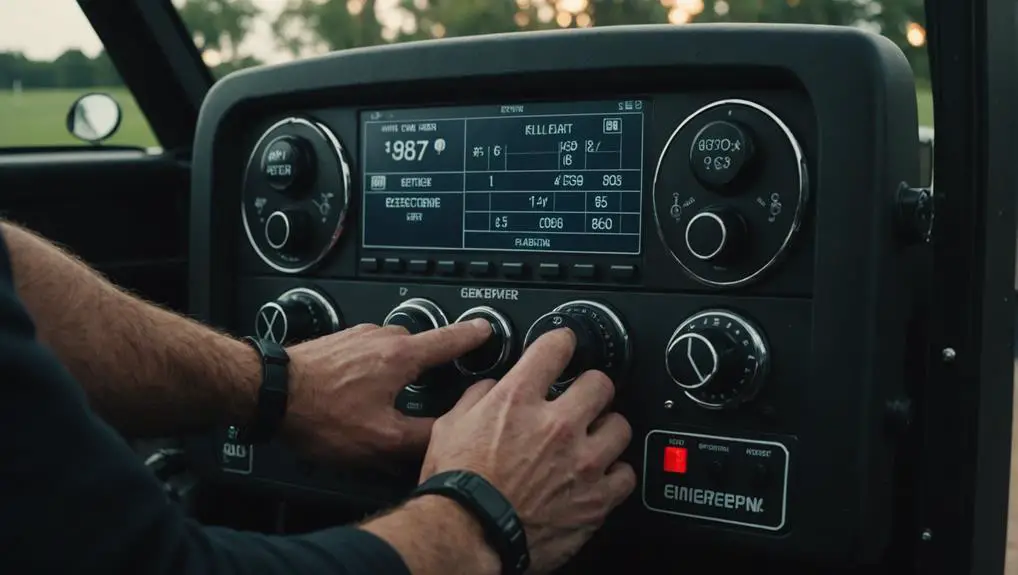Like a car stuck in neutral, your golf cart's reluctance to move forward can be frustrating. You might wonder what's causing this peculiar behavior, especially when it seems perfectly capable of reversing. To troubleshoot effectively, you'll want to start with some basic checks that can often pinpoint the issue. Consider the battery charge, the forward/reverse switch, and other essential components that could be at fault. Understanding these elements could lead you to the solution you need, but the path to resolution isn't always straightforward.
Key Takeaways
- Check the battery charge; ensure it reads at least 12.6 volts to confirm it's fully charged and functional.
- Inspect the forward/reverse switch for wear or damage, testing its functionality with a multimeter for continuity.
- Examine the solenoid for any damage and listen for a clicking sound when pressing the accelerator; measure voltage at its terminals.
- Test the motor connections for voltage across terminals while engaging forward; tighten loose connections and clean corroded terminals if needed.
- Review controller settings and throttle calibration to ensure proper recognition of input and correct programmable settings for forward motion.
Check the Battery Charge
Before you plunge into more complex repairs, it's vital to check the battery charge, as a low battery can prevent your golf cart from moving forward.
Start by locating the battery compartment, typically found beneath the seat or on the rear of the cart. Open the compartment and visually inspect the battery for any signs of corrosion or damage.
Next, use a multimeter to measure the battery voltage. Set the multimeter to the DC voltage setting and connect the red lead to the positive terminal and the black lead to the negative terminal.
A fully charged battery should read around 12.6 volts or higher. If the reading is markedly lower, your battery may be undercharged or faulty.
If your battery's voltage is low, try charging it with an appropriate charger for your specific battery type. Allow it to charge fully before retesting the voltage.
If the battery fails to hold a charge after several attempts, consider replacing it.
Maintaining a healthy battery is essential for peak performance, so regularly check the charge and connections to guarantee reliable operation.
Inspect the Forward/Reverse Switch
Have you checked the forward/reverse switch? This component is essential for controlling your golf cart's direction. If it's malfunctioning, your cart might only reverse while refusing to go forward.
Start by locating the switch, usually found on the dash or near the steering column. Inspect it for any visible signs of wear or damage, such as cracks or corrosion.
Next, test the switch's functionality. With the cart powered on, toggle the switch between forward and reverse while listening for any unusual sounds or resistance. If the switch feels jammed or doesn't click, it may need replacement.
Additionally, use a multimeter to check for continuity. Disconnect the wires connected to the switch, and then test each terminal. If you don't get a reading when the switch is engaged, it's likely faulty.
If your switch appears to be in good condition but the cart still won't go forward, verify the wiring harness connected to the switch is secure and free from damage.
Sometimes, loose connections can cause intermittent issues. Addressing these concerns will help you determine if the forward/reverse switch is the root of your golf cart's problem.
Examine the Solenoid

After ensuring the forward/reverse switch is functioning properly, it's time to examine the solenoid.
The solenoid is a critical component in your golf cart's electrical system, responsible for engaging the motor when you push the accelerator. If your cart won't move forward, the solenoid may be the culprit.
Follow these steps to inspect the solenoid:
- Visual Inspection: Check for any signs of physical damage, corrosion, or loose connections on the solenoid terminals.
- Listen for Clicks: When you press the accelerator, listen for a clicking sound from the solenoid. If you don't hear it, the solenoid may not be activating.
- Test Voltage: Using a multimeter, measure the voltage at the solenoid terminals while someone presses the accelerator. You should see a reading consistent with your battery voltage.
- Check Continuity: Disconnect the solenoid and perform a continuity test. A lack of continuity indicates a faulty solenoid that needs replacement.
Test the Motor Connections
Once you've checked the solenoid, it's essential to test the motor connections to verify they're secure and functioning properly. Start by confirming the golf cart is powered off to prevent any accidental engagement.
Locate the motor connections, which are typically found near the rear of the cart. Inspect both the positive and negative terminals for any signs of corrosion, wear, or damage.
Using a multimeter, measure the voltage across the motor terminals while someone attempts to engage the forward direction. You should see a reading consistent with the battery voltage. If you notice a significant drop or no voltage at all, it indicates a problem in the connections. Tighten any loose connections and clean corroded terminals with a wire brush or appropriate cleaner.
Next, check the wiring for any frays or breaks. If the wiring appears intact, but the issue persists, you may need to disconnect and reattach the motor connections to confirm a solid fit.
After you've completed these steps, power the cart back on and try again. This process can often resolve issues with the motor connections, allowing you to determine if further troubleshooting is necessary.
Review the Controller Settings

Reviewing the controller settings is an essential step in diagnosing why your golf cart won't go forward. The controller manages the power distribution to the motor, and any misconfiguration can prevent forward motion. Here are some key aspects to check:
- Throttle Calibration: Verify the throttle is properly calibrated. If it's not, the controller may not recognize the input when you push the pedal.
- Forward/Reverse Switch: Examine the forward/reverse switch for any signs of wear or damage. A faulty switch can mislead the controller, causing it to only permit reverse movement.
- Controller Connections: Inspect all wiring connections to the controller. Loose or corroded connections can disrupt the signal, preventing forward operation.
- Controller Settings: If your controller has programmable settings, verify that they're set correctly for forward motion. Incorrect settings can lead to operational issues.
Once you've reviewed these elements, you should have a clearer understanding of the controller's role in your golf cart's forward motion.
If issues persist, further troubleshooting or professional assistance may be necessary.
Frequently Asked Questions
What Are Common Signs of a Failing Golf Cart Battery?
When your golf cart battery's failing, you might notice several signs.
First, you may experience reduced power, making it hard to climb hills or maintain speed.
Second, the battery might take longer to charge or show a significant drop in voltage.
Third, you could see physical damage, like bulging or leaking.
Can a Faulty Charger Affect Forward Movement?
Yes, a faulty charger can affect your golf cart's performance, including forward movement.
If the charger isn't delivering the correct voltage or isn't charging the batteries fully, you might experience issues. Insufficient power can lead to a lack of torque, making it difficult for the cart to move forward even if reverse works.
Regularly check your charger and verify it's functioning properly to maintain peak performance in your golf cart.
How Do I Maintain My Golf Cart's Electrical System?
To maintain your golf cart's electrical system, start by regularly checking the battery connections for corrosion and tightness. Clean terminals as needed.
Inspect the wiring for damage, making certain all connections are secure. Test the batteries' charge levels with a voltmeter, and replace any weak batteries promptly.
Additionally, keep the charger in good condition and verify it's functioning properly. Regularly lubricate moving parts to avoid electrical resistance and guarantee smooth operation.
What Tools Do I Need for Golf Cart Repairs?
When you're traversing the landscape of golf cart repairs, think of your toolkit as a compass guiding you through. You'll need basic hand tools like wrenches, screwdrivers, and pliers for mechanical tasks.
A multimeter is essential for diagnosing electrical issues, while a socket set helps with more complex assembly.
Don't forget safety gear, including gloves and goggles, to protect yourself while you work.
With the right tools, you're well-equipped to tackle any repair challenge.
Are There Specific Brands Known for Reliable Golf Cart Parts?
When you're looking for reliable golf cart parts, several brands stand out. Club Car, EZGO, and Yamaha are known for their quality and durability.
You should consider parts from manufacturers like Buggies Unlimited and Golf Cart King, too, as they offer a broad range of aftermarket components.
Always check for warranties and customer reviews to guarantee you're getting dependable parts that'll enhance your cart's performance and longevity.
Conclusion
In the irony of a golf cart that refuses to move forward but will happily reverse, you've got a quirky puzzle to solve. By checking the battery charge, inspecting the forward/reverse switch, examining the solenoid, testing motor connections, and reviewing controller settings, you can uncover the root cause. It's almost like your cart prefers to moonwalk instead of cruising ahead. If all else fails, don't hesitate to call in a professional to restore its forward ambition.